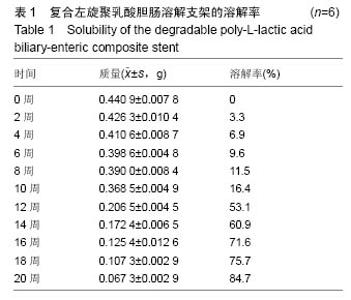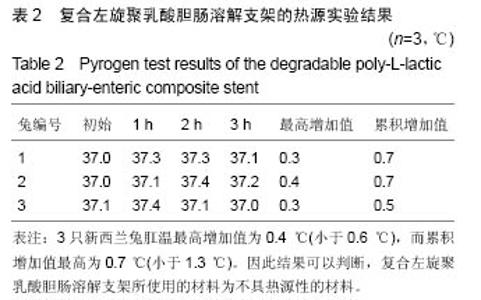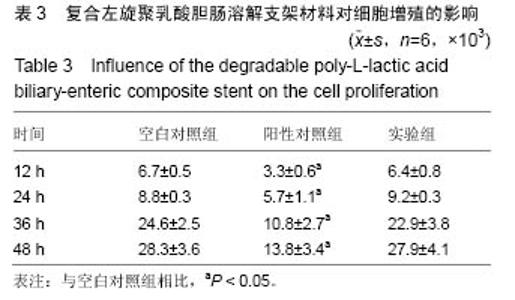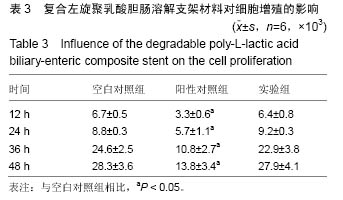| [1]霍凌波,杨滔,申路平,等. 胆肠吻合术的标准化治疗[J].军医进修学院学报, 2012,33(1):98-100.[2]林美举,杨玉龙,张洪威,等.胆肠吻合术后肝内胆管复发结石的微创治疗[J].肝胆胰外科杂志, 2012,24(3): 201-203.[3]温锋,卢再鸣,张军,等.胆肠吻合术后再发梗阻性黄疸的介入治疗[J].中国医学影像学杂志, 2012,20(6):462-464.[4]王禄远.胆肠吻合术围手术期护理体会[J].中外医学研究, 2012,10(36):87-88.[5]Bouletreau P,Jurdic P,Mazzorana M,et al.Evaluation of tissue response to resorbable osteosynthesis materials in maxillofacial surgery. Prospective randomized clinical trial of therapeutic strategy. Rev Stomatol Chir Maxillofac.2005;106(5):316-320.[6]Radin S,El-Bassyouni G,Vresilovic EJ,et al.In vivo tissue response to resorbable silica xerogels as controlled-release materials.Biomaterials. 2005; 26(9):1043-1052.[7]张凯.胆道内可降解支架的体内及体外的实验性研究[D].吉林大学,2004.[8]申震.胆总管探查术后内置可降解支架并行激光焊接胆总管的实验研究[D].吉林大学, 2004.[9]郭俊,沈下贤,张必利,等.可降解支架现状及研究进展[J].介入放射学杂志, 2016,25(2):178-180.[10]冷薇,郑颖,李绍平,等.莪术油在Caco-2细胞模型中的吸收机制研究[J].中国药学杂志, 2007,42(16):1228-1232.[11]李晓敏,刘红宾,呙于明,等.黑酵母β-1,3/1,6-葡聚糖对感染肠炎沙门氏菌Caco-2细胞促炎症和抗炎症细胞因子基因mRNA表达水平的影响[J].动物营养学报, 2013, 25(10):2355-2362.[12]高晨.纳米氧化铜在Caco-2细胞模型及鸡肠道中吸收转运机制的研究[D].吉林大学,2014.[13]潘建国,路继荣,刘书刚.口服凝血酶治疗上消化道出血60例分析[J].潍坊医学院学报, 1998,2(2):17.[14]步雪峰,陈建国,费霞.胃癌相关抗原对消化道肿瘤的诊断价值[J].镇江医学院学报, 1996,6(1):38.[15]陶苏红.超细胆道镜治疗高位胆道狭窄的护理体会[J].护士进修杂志,2011,26(8):722-723.[16]王志强,令狐恩强,蔡逢春,等.肝移植术后胆道狭窄及胆漏的微创治疗[J].中国医刊, 2006,41(5):30-32.[17]李天晓,马南,翟水亭,等.良性胆道狭窄的介入治疗[J].中国介入影像与治疗学, 2007,4(2):123-125.[18]王冠勋.左旋聚乳酸/明胶纳米纤维支架的细胞相容性研究[D].吉林大学,2015.[19]何勇,高兆芬,辛燕,等.左旋聚乳酸的结晶行为研究[J].高等学校化学学报, 2006,27(4):745-748.[20]申晓青,李少萍.左旋聚乳酸-甲壳素共混材料体外降解的形态学观察[J].广东牙病防治, 2007,15(8):345-347.[21]刘达,雷伟,吴子祥,等.生物材料强化椎弓根螺钉稳定性研究进展[J].国际骨科学杂志, 2009,30(3):148-151.[22]夏维娟,张智华,庹新林.提高聚氨酯生物稳定性和相容性的研究进展[J].高分子通报, 2011,24(4):164-171.[23]Rosario-Melendez R,Yu W,Uhrich KE.Biodegradable polyesters containing ibuprofen and naproxen as pendant groups.Biomacromolecules. 2013;14(10): 3542-3548.[24]Diaz A,Katsarava R,Puiggali J.Synthesis, properties and applications of biodegradable polymers derived from diols and dicarboxylic acids: from polyesters to poly(ester amide)s.Int J Mol Sci. 2014;15(5):7064- 7123.[25]汪穗福,张坤.2001年我国中药注射剂细菌内毒素检查的研究[C].全国第5届天然药物资源学术研讨会,中国宁夏银川,2002.[26]夏振民.浅谈药品注射剂之热原[J].中国药房, 1992,24(4): 38.[27]佃少娜,伍善广,李桃,等.肺靶向红霉素明胶微球的安全性评价[J].中国药房,2008,19(4):261-263.[28]邢东炜,唐岚,张闽光,等.天冬胶的溶血实验[J].时珍国医国药,2005,16(11):1067-1068.[29]恽时锋.新西兰白兔体温变化规律及其在热源试验中的应用[J].中国养兔杂志, 1997,16(4):30-33.[30]何万领,李晓丽,杨肖娥.两个Caco-2细胞系模型铁生物有效性评价效果研究[J].河南师范大学学报(自然科学版), 2010,38(3):119-122.[31]徐鹏辉,陈小章,高杰英.人结肠癌上皮细胞系Caco-2与肠上皮间淋巴细胞共培养对上皮细胞屏障功能的影响[C].中国免疫学会第四届学术大会,中国河北石家庄,2002.[32]祝欣刚,杨青.人结肠腺癌细胞系Caco-2单细胞层短期培养法及其评价[J].复旦学报(医学版),2012,39(1):68-73.[33]张延清,戴海滨,王京华,等.连续动态观察乳酸脱氢酶对MDS预后判定的意义[J].中国实验血液学杂志, 2011, 19(1): 85-89.[34]吴音,冷青,季征,等.乳酸脱氢酶、β_2微球蛋白在急性白血病中的临床意义[J].中国医疗前沿,2011,6(3):8-9.[35]洪庆涛,宋岳涛,唐一鹏,等.细胞培养液乳酸脱氢酶漏出率的比色测定及其应用[J].细胞生物学杂志, 2004,26(1): 89-92.[36]李阳,孙世光,谢予朋,等.徐长卿提取物对损伤内皮细胞中乳酸脱氢酶、肿瘤坏死因子及白细胞介素-8活性的影响[J].中国医药导报,2013,10(28):10-12. |





